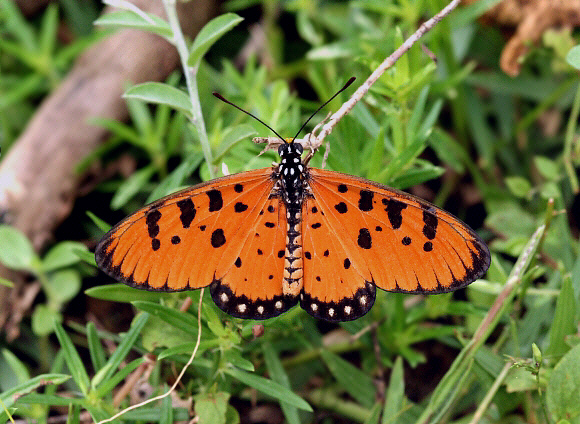
Introduction
The Heliconiinae comprises of 3 tribes – Acraeini, Argynnini and Heliconiini. The Acraeini includes the Neotropical genera Abananote, Altinote and Actinote; and the Oriental / Australian Cethosia, as well as Acraea which includes 230 African species, one Australian species, and 5 in the Oriental region.
All Acraea species have elongate forewings and rounded hindwings. The wings are thinly scaled to the extent that in many species they are semi-transparent. The scales tend to get rubbed off very easily so that insects more than 4 or 5 days old have a distinctly glassy or greasy appearance. The majority of species are predominantly brownish or greyish in ground colour, and are marked with bands or patches of red or orange. The basal area of the underside hindwings of most species is marked with a pattern of small black spots.
Acraea violae ( incorrectly referred to as A. terpsicore in some works ) is found in India, Sri Lanka, Bangladesh, Burma and Thailand.
Habitats
This is a relatively common species occurring primarily at low altitudes on scrubby grasslands, dry open woodlands, beach hinterlands and flowery gardens. It has however been recorded as high as 2000m in the Western Ghats of India. The butterfly is seen in the highest numbers in the monsoon seasons, and is quite scarce at the peak of the dry season.
Lifecycle
The eggs are yellowish, and laid carefully spaced, in neat batches on the underside of leaves of the foodplants.
The fully grown larvae are a dark, glossy reddish-brown colour, except for the thoracic segments which are whitish. The thorax and abdomen are equipped with multi-branched black spines along the back and sides.
The pupa is attached horizontally by the cremaster to a stem. It is whitish, streaked with black on the wing cases. There are black stripes along the back and sides, and within the stripes is a series of small yellowish spots.
The larval foodplants include various genera in the Loganiaceae, Cucurbitaceae and Passifloraceae. These plants contain toxins that are sequestered by the larvae and inherited by the adult insects. The toxicity of the adults, in conjunction with their orange aposematic colouration, affords them with a high degree of protection against insectivorous birds.
Adult behaviour
This is a colony-forming species. Even in marginal habitats it is uncommon to see less than half a dozen flying together, while prime habitats often contain hundreds. On hot sunny days in April I have often seen swarms of these butterflies flying in savannah / woodland mosaics in Sri Lanka.
Both sexes nectar avidly at Tridax, Tagetes, Lantana and other wild or cultivated flowers. They usually hold their wings erect while feeding, but often pause to bask on flowers or vegetation with their wings outspread, with the forewings half masking the hindwings. The butterflies are normally active, nervous, and difficult to approach. The flight is weak and fluttery, but persistent.
In cloudy weather they roost openly on woody stems or on grass-heads.
